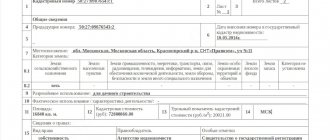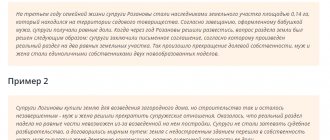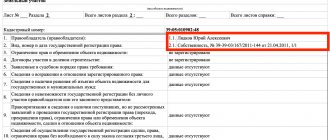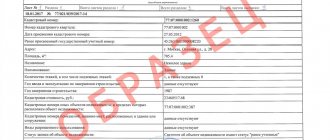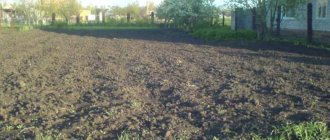Share with family and friends:
The allocation of a share in kind of a land plot from common shared ownership is the legal registration of part of a large plot into an independent real estate object that has certain boundaries and an individual cadastral number. Typically, the need for such a procedure arises if at first several people owned the land at once, but they decided to leave shared ownership and register the plots for individual use. Most often, this is due to planning the sale of the share.
General principles for allocating shares
Based on the Civil Code, the use and ownership of a property that is in shared ownership occurs with the agreement of all co-shareholders. In this case, two concepts are distinguished:
- real share - part of the site, the boundaries of which can be clearly marked on the ground;
- The ideal share is a value that actually exists only on paper; it is impossible to draw boundaries on it.
Property can be divided among all property participants by agreement. If the shareholders cannot agree among themselves, the division of property will take place in court. This procedure is regulated by Article 252 of the Civil Code, in particular paragraphs 1 and 3, and Article 11.4 and No. 11.5 of the Land Code. As a rule, determining the size of the formed plots depends on the share that each of the co-owners has.
According to Russian legislation, a land plot can be divided not only by plane, but also by levels:
- aboveground;
- underground;
- ground.
What is an easement
An easement is a permission granted by the owner to use a piece of land to another person with certain restrictions. It is distinguished from leasing by the possibility of concluding an agreement in a forced form and the impossibility of making a profit by the tenant.
Such use of land is based, for example, on the need to fulfill economic needs (laying electrical networks, water supply, etc.) and involves the conclusion of an easement agreement.
Land easement agreement
An easement agreement for a land plot is an agreement concluded between the owner of the plot and its user, which contains the following data:
- boundaries of the site (according to geodesy and land surveying);
- Full name and other data of the parties;
- information about the land allotment placed at the disposal of the tenant under an easement agreement;
- fees charged for the use of land;
- duration of the contract (by law);
- obligations and rights of the parties;
- list of attached documents and other information.
The agreement is registered in Rosreestr at the location of the land mass.
Requirements for sites
The division of property can be carried out only if, as a result of the procedure, a plot is formed, the total area of which is not lower than the minimum norm for the provision of an allotment for a certain subject of the Russian Federation. This information can be found in the municipality or regional legislation.
If you ignore these values, then even after carrying out land surveying work, state registration will be denied. And this applies to all shares. If a small part of the plot belongs not to the initiator of the division, but to another co-owner, the transaction will still not be registered.
The allocation of a share in kind is possible only if, as a result of the procedure, the points and boundaries between the resulting plots are clearly marked. If, when dividing a plot with a house, the red line runs through the middle of a permanent building, such a property will not be registered.
There are also general requirements for emerging areas:
- each plot must have free access to the road;
- areas must be of an even geometric shape without peaks or notches;
- Separate parts of plots should not overlap each other.
How to calculate the share in the right
The share in the plot is calculated extremely simply. If the certificate of ownership for the entire plot already indicates fractional ownership of the land, then the total area of the object should be taken as X, and the share as Y (for example, it is equal to 1/3). The exact number of acres is calculated using the formula:
X*Y=M.
If the size of the shares is not determined, then the plot is divided between all co-owners into equal parts. If the owners are unhappy with this, they establish a procedure for use with the determination of shares through the court. To isolate a share, it is necessary that this share be determined in fractions.
Nuances of joint ownership of land
In cases where two or more persons own a land plot without allocating shares, and other legal acts do not establish another legal regime, a regime of common joint ownership is established. This means that the owners jointly own and use common property, unless otherwise provided by agreement between them.
When making a transaction to dispose of common property, the mandatory consent of the co-owners is required.
Thus, the purchase of real estate by spouses during marriage (including a plot of land) implies that any actions to dispose of it require the notarized consent of the husband or wife.
If a transaction is made without the consent of the second party, it may be declared invalid within 1 year from the moment when the second spouse should have known or learned about the commission of such actions. This provision is enshrined in Art. 35.
According to the law, several or two persons have the right of common joint ownership of land if they are:
- spouses in an officially registered marriage (Article 256 of the Civil Code);
- members of a peasant (farm) enterprise (Article 257 of the Civil Code);
- participants in a simple partnership agreement;
- in other cases.
In addition to situations provided for by the legislation of the Russian Federation, common joint property can arise on a contractual basis. A contract of joint ownership of land arises when the legal owners voluntarily unite the land plots they own, securing the agreements they have reached in an appropriate document drawn up in the prescribed manner.
Stages of selection in kind
The procedure for allocating a share occurs in several general stages:
- an allotment plan is drawn up;
- the boundaries of the allotment are established and agreed upon with neighbors;
- standard land surveying is carried out (officially within 15 days, but usually faster);
- a land survey is being prepared - the main document on ownership of the new plot, it has important functions: it determines the conditions for the emergence of a new right;
- describes the technical characteristics of the object;
Before carrying out the procedure, it is necessary to determine the location of the allotment and agree on its location together with the participants in shared ownership. The object from which the allocation will be made does not change its boundaries relative to neighboring plots.
Step-by-step allocation of shares in kind, if all owners agree
If all co-owners agree to the procedure, then the allocation of the share is as follows:
- the initiator of the division holds a meeting of co-owners of the land, warning all participants at least 10 days before the actual meeting;
- as a result of the meeting of participants, a general agreement is reached, which is recorded in the minutes; all co-owners must sign this document;
- execution of a separation agreement; soglashenie-o-razdele-doma-nahodyaschegosya-v-dolevoy-sobstvennosti-3683-large
- if the normal functioning of plots requires their increase or reduction, then such operations can be changed, and the owners of the reduced plots are paid monetary compensation;
- a licensed cadastral engineer is ordered to carry out land surveying;
- the boundary act is signed by the participants in shared ownership and the owners of adjacent plots;
- signing a survey act is not required in the case of division of agricultural land, if the co-owners have previously given their written consent to the allocation of a land share (based on Article No. 13 101-FZ);
- documents are drawn up in the Registration Chamber, new objects are assigned cadastral numbers and postal addresses.
State registration of rights to all received plots will be carried out simultaneously. In this case, the old plot as an object of law ceases to exist.
Required documents
When registering the allocation of a share, the following documents are required to be submitted to the registration authority:
- USRN extract;
- statement of decision to allocate a share;
- separation agreement;
- minutes of the general meeting;
- certificates of ownership of a common plot;
- documentation prepared by a cadastral engineer, incl. act of land surveying;
- cadastral passport;
- copies of ID cards of co-owners.
If the papers will be submitted by the owner’s representative, then a notarized power of attorney will need to be attached to the documentation package.
Shared ownership of agricultural land
This type of ownership applies to agricultural land - territories that are located outside the boundaries of settlements, provided and used for agricultural needs. Such lands are endowed with a special status and their turnover is strictly regulated.
The right of common ownership of them can arise in several cases:
- as a result of civil transactions (when several citizens jointly decided to buy a plot, it became property upon execution of a gift agreement or was inherited by will or by law);
- during privatization - the land is transferred to the user under the conditions determined by the law of July 24, 2002 No. 101-FZ, with the emergence of private ownership of it;
- when creating peasant farms, when citizens can receive land plots for rent with subsequent purchase, which will result in common ownership of agricultural land.
When to go to court
You have to go to court if:
- the share does not have the necessary title and title documents (stake agreement, share donation agreement, etc.);
- the size of the share indicated in the certificate does not correspond to reality;
- there is a conflict between the co-owners of the plots;
- local authorities oppose the allocation of shares.
When allocating a land share, you will need to apply to the district court at the location of the property. The period for consideration of the case will be 60 days. Any court decision has the legal force of a traditional title document. It can be appealed within 10 days after acceptance.
Judicial practice shows that usually the court meets the plaintiff halfway and allocates a share of the plot in kind, if this does not contradict the law, and also does not entail the termination of property rights of any third parties without appropriate material compensation.
The separation of a part of an allotment from common shared property is a fairly common transaction, but without proper legal preparation, its completion may be accompanied by certain difficulties. Therefore, when it occurs, it makes sense for at least one co-owner to contact a lawyer or realtor.
1 comment
Cancel reply
- Sasha (3 years ago)
In conclusion, I would like to note that currently the number of disputes regarding the allocation of shares from common property has increased significantly, as evidenced by numerous judicial practices. Thus, if the court refuses to satisfy the owner’s claim for the allocation of a share in kind, this does not prevent the owner from subsequently filing a claim with the court to determine the procedure for using the residential premises on the basis of Art. 247 Civil Code of the Russian Federation.
Answer
Next article >
